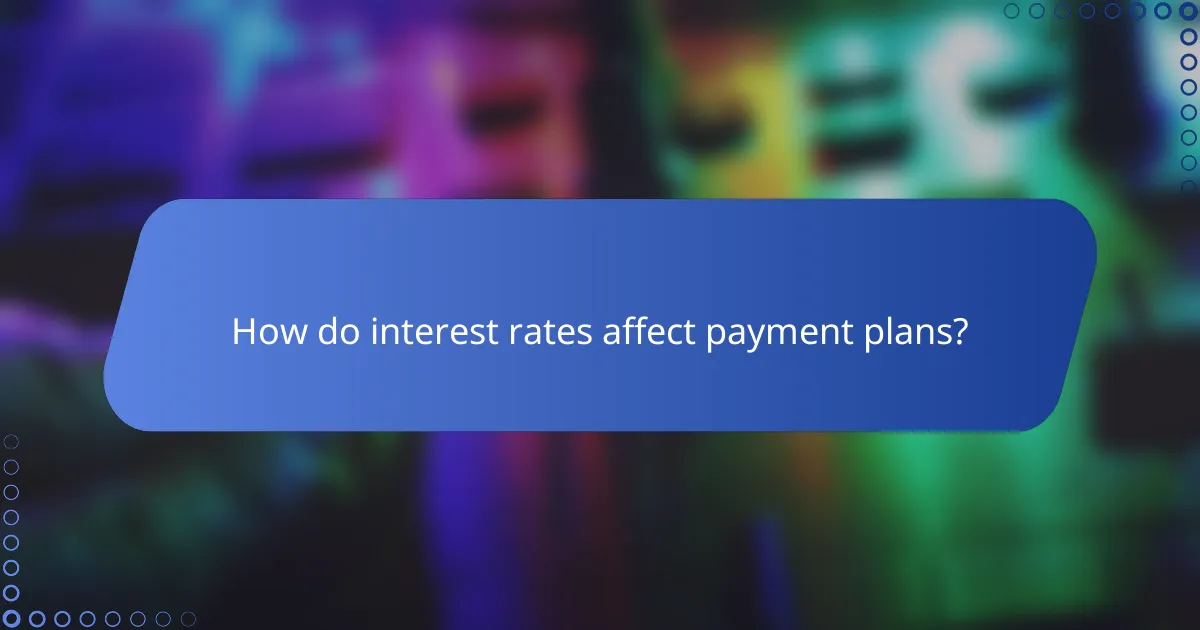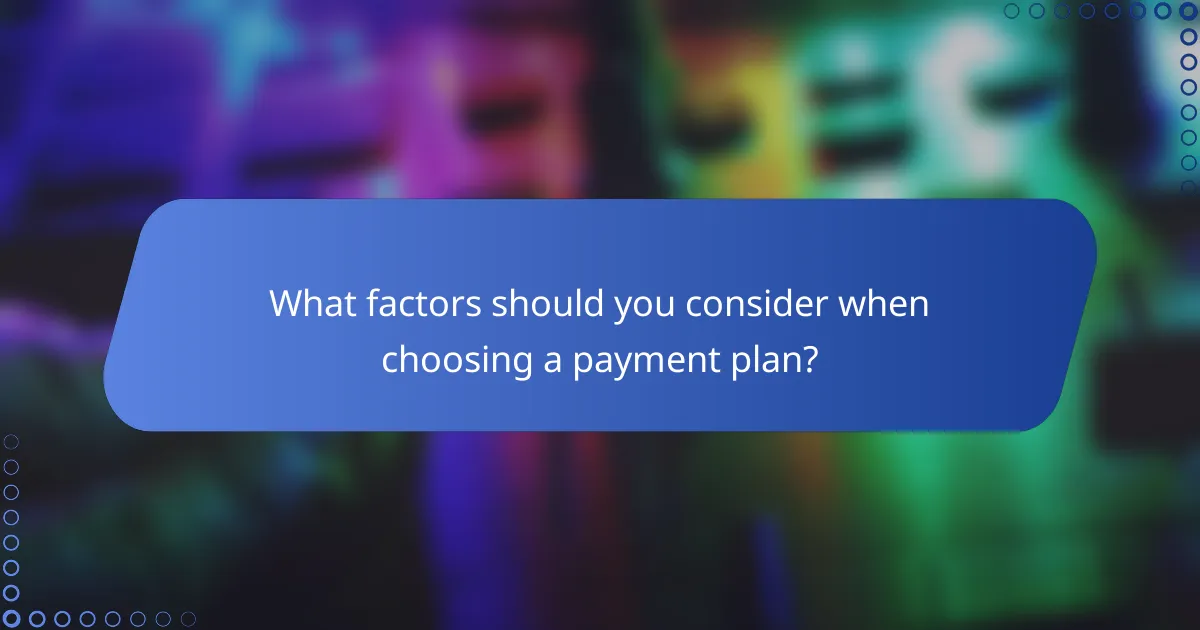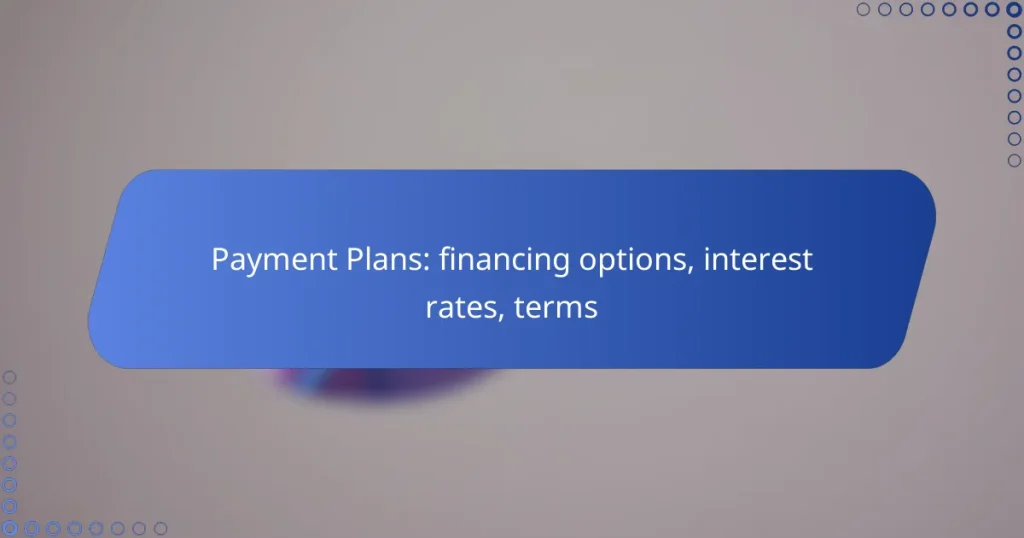Payment plans provide consumers with flexible financing options that accommodate various purchasing needs. By offering manageable interest rates and clearly defined terms, these plans make it easier to budget and repay over time, ensuring accessibility for a wide range of financial situations.

What are the best payment plans available in Canada?
The best payment plans in Canada offer flexible financing options that cater to various consumer needs. These plans typically feature manageable interest rates and terms that allow for easy repayment, making them accessible for a wide range of purchases.
Affirm financing options
Affirm provides Canadians with straightforward financing options for online purchases. Customers can choose to pay over three, six, or twelve months, with interest rates that may vary based on creditworthiness, typically ranging from 0% to 30% APR.
To use Affirm, simply select it as a payment method at checkout, and complete a quick application. Approval is usually instant, allowing you to finalize your purchase immediately.
PayBright payment plans
PayBright offers flexible payment plans that allow consumers to split their purchases into manageable installments. Customers can choose terms from 3 to 60 months, with interest rates that generally range from 0% to 29.95% APR, depending on the plan selected.
To utilize PayBright, select it at checkout, fill out a brief application, and receive an instant decision. This option is popular for larger purchases, such as electronics or furniture.
Afterpay installment payments
Afterpay allows Canadians to pay for their purchases in four equal installments, due every two weeks. This plan is interest-free, making it an attractive option for consumers looking to manage their cash flow without incurring extra costs.
To use Afterpay, simply select it at checkout, create an account, and make your first payment. The remaining installments are automatically charged to your chosen payment method.
Sezzle financing solutions
Sezzle offers a buy now, pay later service that divides your purchase into four interest-free payments, due every two weeks. This option is designed to help consumers manage their budgets while shopping online.
To get started with Sezzle, choose it as your payment method at checkout, create an account, and make your first payment. The remaining payments will be automatically deducted from your account, making it a hassle-free option.
Flexiti payment options
Flexiti provides flexible financing solutions for consumers looking to make larger purchases. Customers can choose from various plans, typically ranging from 6 to 60 months, with interest rates that can vary based on credit assessment.
To use Flexiti, select it at checkout and complete a quick application. Approval is usually instantaneous, allowing you to proceed with your purchase without delay.

How do interest rates affect payment plans?
Interest rates play a crucial role in determining the overall cost of payment plans. Higher rates increase the total amount paid over time, while lower rates can make financing more affordable.
Fixed vs variable interest rates
Fixed interest rates remain constant throughout the life of the payment plan, providing predictability in monthly payments. This stability can be beneficial for budgeting, as borrowers know exactly what to expect.
Variable interest rates, on the other hand, can fluctuate based on market conditions. While they may start lower than fixed rates, they carry the risk of increasing, which can lead to higher payments over time.
Typical interest rates in Canada
In Canada, typical interest rates for payment plans can range from low single digits to high teens, depending on the lender and the borrower’s creditworthiness. For example, personal loans might have rates between 5% and 15%, while credit cards can exceed 20%.
It’s important to shop around and compare offers, as rates can vary significantly between financial institutions. Always consider the total cost of borrowing, not just the interest rate.
Impact of credit score on rates
Your credit score significantly influences the interest rates you can secure for payment plans. Higher credit scores generally lead to lower rates, as lenders view these borrowers as less risky.
Conversely, individuals with lower credit scores may face higher rates or may not qualify for certain financing options. It’s advisable to check your credit report and address any issues before applying for a loan to improve your chances of obtaining favorable terms.

What are the terms of payment plans?
Payment plans typically involve a structured agreement outlining how much you will pay, the frequency of payments, and the duration of the financing. Understanding these terms is crucial for managing your finances and ensuring you can meet your obligations without incurring additional fees.
Common payment terms in Canada
In Canada, payment plans often include terms such as monthly payments, interest rates, and total repayment amounts. Typical interest rates can range from low single digits to high double digits, depending on the lender and the borrower’s creditworthiness. It’s common for payment plans to span several months to a few years.
Many lenders also offer flexible payment options, allowing borrowers to choose between fixed or variable interest rates. Fixed rates provide stability, while variable rates may fluctuate with market conditions.
Duration of financing agreements
The duration of financing agreements can vary widely, generally lasting from six months to several years. Short-term plans may be suitable for smaller purchases, while larger loans often extend over a longer period, sometimes up to five years or more.
When considering the duration, it’s essential to balance the monthly payment amount with the total interest paid over the life of the loan. Shorter terms usually mean higher monthly payments but lower total interest costs.
Late payment penalties
Late payment penalties can significantly impact your overall costs. In Canada, these penalties typically range from a fixed fee to a percentage of the missed payment, often around 1.5% to 3% of the overdue amount. It’s crucial to read the fine print of your agreement to understand these fees.
To avoid late fees, set up reminders or automatic payments. If you anticipate difficulty making a payment, contact your lender as soon as possible to discuss potential solutions, such as payment deferrals or restructuring the loan terms.

What factors should you consider when choosing a payment plan?
When selecting a payment plan, consider your monthly budget, the total cost of financing, and the flexibility of payment options. These factors will help you determine the most suitable plan for your financial situation and goals.
Monthly payment affordability
Affordability of monthly payments is crucial when choosing a payment plan. Assess your income and expenses to determine how much you can comfortably allocate each month without straining your finances. A good rule of thumb is to keep your payment within 15-20% of your monthly income.
For example, if your monthly income is $3,000, aim for payments between $450 and $600. This ensures you can meet your obligations while still covering other essential expenses.
Overall cost of financing
The overall cost of financing includes interest rates, fees, and the total amount paid over the life of the loan. Compare different plans to understand how these costs add up. A lower monthly payment might seem appealing, but it could lead to higher total costs due to extended terms or higher interest rates.
For instance, a plan with a 5% interest rate over five years may cost less than one with a 7% rate over three years, despite similar monthly payments. Always calculate the total repayment amount to make an informed decision.
Flexibility of payment options
Flexibility in payment options can significantly affect your ability to manage your finances. Look for plans that allow for extra payments, deferments, or adjustments based on your financial situation. This can provide peace of mind during unexpected circumstances.
Some lenders offer options like bi-weekly payments or the ability to skip a payment without penalty. Evaluate these features to ensure the plan aligns with your lifestyle and potential changes in income.

How do payment plans compare to credit cards?
Payment plans typically offer a structured way to finance purchases, often with fixed terms and predictable payments, unlike credit cards which can carry variable interest rates and revolving balances. While both options provide flexibility, understanding their differences in costs and terms is essential for making informed financial decisions.
Interest rates comparison
Payment plans often feature lower interest rates compared to credit cards, which can have rates ranging from low single digits to high double digits, depending on the issuer and the borrower’s creditworthiness. Many payment plans may even offer promotional periods with 0% interest, making them an attractive option for financing larger purchases.
For instance, a payment plan might charge an interest rate of around 5-10%, while a credit card could charge upwards of 15-25%. It’s crucial to compare these rates before committing to either option.
Fees and penalties
Payment plans generally have fewer fees than credit cards, which often include annual fees, late payment charges, and foreign transaction fees. Payment plans may include a one-time setup fee or a late payment penalty, but these are usually more predictable.
Be aware that missing a payment on a credit card can lead to higher interest rates and additional penalties, whereas payment plans may offer more leniency with grace periods. Always read the terms carefully to avoid unexpected charges.
Benefits of using payment plans
One significant benefit of payment plans is the ability to budget effectively, as they provide fixed monthly payments over a set period. This predictability can help consumers manage their finances without the risk of accumulating debt that can spiral out of control, as is common with credit cards.
Additionally, payment plans can enhance purchasing power by allowing consumers to acquire items they may not afford upfront, often without the burden of high-interest rates. This can be particularly beneficial for larger purchases like appliances or furniture, where spreading the cost over several months makes financial sense.

What are the advantages of using payment plans for e-commerce?
Payment plans for e-commerce provide consumers with flexibility and affordability, allowing them to purchase items without immediate full payment. These options can enhance customer satisfaction and increase sales for businesses by making higher-priced products more accessible.
Financing options available for consumers
Consumers can choose from various financing options when using payment plans, including buy now, pay later services, installment loans, and credit cards with promotional offers. Each option has different terms, interest rates, and repayment schedules, making it essential for shoppers to compare them based on their financial situation.
For example, buy now, pay later services often allow customers to split payments into smaller, interest-free installments over a few weeks or months. In contrast, traditional installment loans may involve longer repayment periods with interest, making them suitable for larger purchases.
Understanding interest rates and fees
Interest rates and fees can significantly impact the overall cost of using payment plans. Some financing options may offer low or zero interest for a promotional period, while others may charge higher rates after that period ends. It’s crucial for consumers to read the fine print and understand the total cost of financing before committing.
For instance, a payment plan with a 0% interest rate for six months can be beneficial if the balance is paid off within that timeframe. However, if the balance remains after the promotional period, the interest rate may jump to a much higher percentage, increasing the total amount owed.
Terms and conditions to consider
When evaluating payment plans, consumers should pay attention to the terms and conditions, including repayment timelines, late fees, and the impact on credit scores. Many payment plans require timely payments to avoid penalties, which can lead to additional charges and affect creditworthiness.
Additionally, some plans may have specific eligibility requirements or restrictions on the types of purchases allowed. Understanding these terms helps consumers make informed decisions and avoid potential pitfalls associated with missed payments or unexpected fees.


